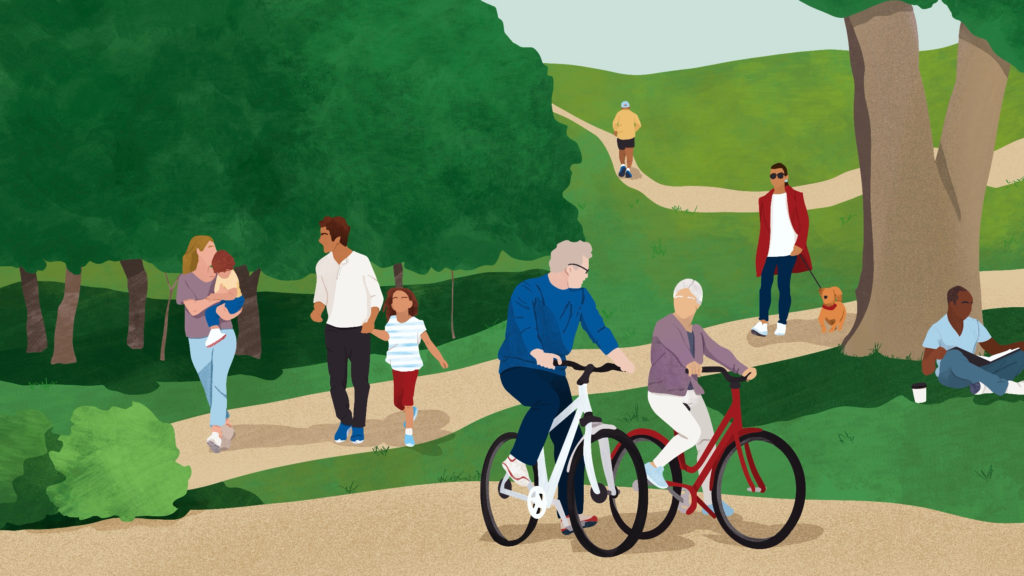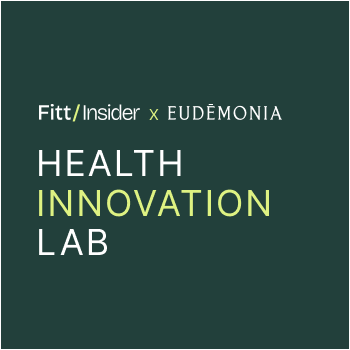Shut in and staring at screens, America’s sedentary ways worsened over the last year.
Now, as the economy reopens, promoting physical activity, not exercise or fitness, should be a post-pandemic priority.
Wake-up Call
It’s no secret America is alarmingly unfit.
- In the US, 73% of adults and 35% of children are overweight or obese.
- By 2030, nearly 50% of US adults are projected to have obesity.
- Over the next decade, healthcare costs attributable to obesity/overweight could reach $956B annually.
And coronavirus shined a spotlight on this fact:
- 78% of people who were hospitalized, placed on a ventilator, or died from COVID-19 were overweight or obese.
Looking closer. After old age, obesity is the second-leading risk factor in COVID-related deaths. As many as 30% of coronavirus hospitalizations are linked to obesity. The risk of death from COVID-19 is 10x higher in countries where most of the population is overweight.
According to The Lancet editor-in-chief Richard Horton, COVID-19 isn’t a pandemic but a “syndemic“—a synergistic epidemic of underlying health problems with a deadly infectious disease—adding:
“Addressing COVID-19 means addressing hypertension, obesity, diabetes, cardiovascular and chronic respiratory diseases, and cancer.”
Two Pandemics
The fourth-leading cause of death worldwide, physical inactivity, was labeled a global pandemic in 2012.
- More than 15% of US adults are physically inactive.
- About 23% of adults nationally meet the federal physical activity guidelines.
- Physical inactivity accounts for 11% of US healthcare expenditures, or $117B/yr.
More than COVID-19, experts believe sedentary behavior will plague us for years to come:
“All data convincingly indicates the physical inactivity pandemic will persist long after we recover from the COVID-19 pandemic – the health and economic impacts of the physical inactivity pandemic, for which no end is in sight, will continue to be severe.”
Making matters worse, early indications point to a rise in weight gain during lockdown — a recent study found that 42% of people reported gaining weight since the pandemic began. The average addition was 29lbs, while 10% reported gaining more than 50lbs.
The catch? Unlike coronavirus, obesity and most chronic illnesses are preventable.
According to McKinsey, by 2040, America could reduce its disease burden by as much as one-third simply by increasing access to preventive interventions, like weight management, smoking cessation, preventive generic drugs, and routine vaccinations.
Ignoring the upside, preventive care spending in the US declined as a percent of total national health spending, from 3.7% in 2000 to 2.9% in 2018. Meanwhile, as individuals, we often fail to prioritize personal well-being, at times acting in opposition to our own best interests.
The Peloton Economy
For years, as obesity rates climbed, the fitness industry boomed.
Before coronavirus shuttered gyms, industry revenues topped $35B in 2019. While in-person exercise disappeared during the pandemic, shrinking revenues by 58% in the process, spending on digital/connected fitness options for home use soared.
Forecasting $4B in revenue for 2021, Peloton’s biggest issue is meeting demand. Elsewhere, MIRROR saw 2020 revenue reach $170M. And, last year, Tonal’s sales jumped 800%.
In-person or at-home, the so-called fitness boom is largely confined to the wealthy and already-fit.
As Canaan partner Byron Ling told us on the Fitt Insider podcast:
“The reality is, not everyone can afford a Peloton. I think there’s still a white space for more accessible solutions. From kids to seniors, it’s less about the brand and more about the impact.”
Further, a Marker article framed Peloton’s meteoric rise as a cautionary tale of the haves and have nots:
“The million or so Peloton owners and their professional-class peers Zooming and home-ordering from Whole Foods through the pandemic recession — is the Peloton Economy. It’s gotten quite a bit of attention in a year when health and economic forces have simultaneously upturned and ended lives month after month. But ultimately, we need to face up to the fact that the Peloton Economy is not a bellwether — it’s a warning signal…”
Physical Activity for All
The opposite of expensive or exclusive exercise, it’s time to make physical activity the top priority.
We use words like fitness, exercise, and activity interchangeably, but they’re very different. Exercise is a structured regimen. Fitness is performance-based. But physical activity is movement — the kind that gets us off the couch and away from screens. Best case, it’s outside in nature.
“Being physically active outdoors helps people to maintain proper weight, reduces the risk of diabetes and heart disease, benefits bone health, lowers stress and improves emotional well-being.” – Dr. JoAnn Manson, Harvard professor and chief of preventive medicine at Brigham and Women’s Hospital
Unlike fitness or exercise, where we’re striving toward a specific goal, in promoting physical activity, movement is the goal. Move more, move often.
According to Daniel E. Lieberman, professor of evolutionary biology at Harvard, humans evolved to be active, but exercise isn’t the answer. He noted:
“We’ve medicalized [exercise], we’ve commercialized it, we’ve commodified it. And look, it’s true, exercise is good for you. But it’s a very modern behavior. Until recently, nobody had the choice but to be very physically active—or moderately physically active, not crazy physically active.”
Lieberman’s solution? Compel people to be active and make exercise fun, adding:
“The bottom line is that just as cultural innovations are causing the physical activity epidemic, new cultural measures are needed to restore the need to move in our environments. Until we do so effectively, we can expect to remain trapped in a pernicious vicious circle in which, by treating the symptoms rather than the causes of diseases that are caused by physical inactivity, we will permit the exercise paradox to persist and worsen.”
Takeaway: While the work of reshaping environments and altering behaviors continues, we can heed Lieberman’s simple advice: “Any movement is an improvement on none, more is usually better, and it is never too late to start.”
🎙 On the Podcast
This week, on the Fitt Insider podcast, we’re joined by Jacob Rothman, co-founder and CEO of Perch — a velocity-based training system that uses 3D cameras to quantify and improve performance.
In this episode, we discuss:
- Using technology to improve strength training
- Targeting elite athletes before expanding into the consumer market
- The role of content, community, and data in the future of strength training
Listen to the full episode here.
🤝 Done Deal
A few weeks back, Tempo was said to be raising new capital in a funding round of “more than $100M.”
Update: The deal is done, and Tempo closed a $220M Series C led by SoftBank. The company has now raised $300M to date.
According to the press release, Tempo’s sales increased by 10x in 2020 with zero subscription cancellations.
Zooming out: As we detailed in Issue No. 125, Tempo is trying to keep pace with Tonal as the Smart Strength category bulks up.
🎯 So Far, So Good
In June ’20, lululemon paid $500M for MIRROR. Here’s how the acquisition is playing out:
- 2020: The company earned $170M in revenue.
- 2021: Revenues are forecasted to rise as much as 65% to $275M.
- 2023: Sales could reach $700M w/600K subscribers by 2023, per BoA.
At this rate, MIRROR would be better than break-even on the acquisition price within three years.
According to lululemon CEO Calvin McDonald, on average, there are more than two MIRROR users per household. And, emphasizing the variety of content, McDonald said users take six different types of workouts each month.
Investing in growth, lululemon plans to:
- add two more production studios
- triple the number of live classes
- hire seven additional instructors to the roster of 15 — all of whom will be lululemon ambassadors
Emphasizing the long-term vision, McDonald added:
“We started the process to purchase Mirror before the global pandemic began… I don’t expect the pandemic tailwinds to disappear once mass vaccinations have occurred.”
Looking ahead: As the economy (and gyms/studios) reopens, lululemon expects its bet on the omnichannel guest experience to pay off.
📰 News & Notes
- The best watch for cyclists.
- The 2020 bike boom continues.
- The most valuable apparel brand.
- Retro Fitness launches at-home bike.
- Gen Z Water: Flavorless Transparent Liquid.
- Playpulse kicks off pre-orders for its “gaming bike”.
- Amazon unveiled Aplenty, a new private-label food brand.
- LeBron’s agent, ex-Nike execs to build sports/wellness brands.
💰 Money Moves
- Impossible Foods is preparing for a public listing that could value the plant-based burger maker north of $10B.
- Better Therapeutics, a digital therapeutics company, plans to go public today in a SPAC merger with Mountain Crest Acquisition Corp. II.
- The Honest Company, the all-natural household products company co-founded by Jessica Alba, filed for an initial public offering.
- ABC Fitness Solutions, a software provider for health/fitness businesses, acquired all-in-one data solution Fitness BI.
- Smart gym maker Tempo closed $220M in Series C funding led by SoftBank.
More from Fitt Insider: Smart Strength - Moxie, a platform for fitness instructors to host live/on-demand classes, raised $6.3M in seed funding led by Resolute Ventures.
More from Fitt Insider: Arming the Rebels - Smart mattress maker Eight Sleep landed an undisclosed investment from SoftBank.
More from Fitt Insider: Selling Sleep - Procter & Gamble acquired Australian effervescent vitamins brand VÖOST Vitamins for an undisclosed sum.
More from Fitt Insider: In Supplements We Trust - Warsaw-based personalized supplement maker Sundose closed $6M in Series A funding.
- Powdered beverage maker MANTRA Labs closed a $1.5M seed round.
- Papa, an elder tech company offering care and companionship to seniors, added $60M in a Series C led by Tiger Global Management.
More from Fitt Insider: The Senior Care Crisis - Vesta Healthcare, a digital home-based care platform, pulled in $65M in funding.
- Getlabs, an at-home lab testing company, closed a $3M seed round.
- Realworld, an app that helps Gen Z navigate adulthood, raised $3.4M in seed funding.
- UK-based team sports tracking platform PlayerData landed a $2.3M investment led by Hiro Capital.
More from Fitt Insider: The Quantified Athlete - Tend, a tech-driven dentistry startup, raised $125M in Series C funding.
- MINDCURE, a psychedelic therapy company, acquired an additional equity stake in ATMA Journey Centers.
More from Fitt Insider: Psychedelic Wellness - Territory Foods, a chef-prepared meal delivery company, raised $22M in Series B funding.
More from Fitt Insider: The Future of Meal Kits - Gathered Foods, makers of Good Catch plant-based seafood, secured $26M in new funding.
- Chickpea pasta maker Chickapea raised $9.3M in new funding.
- Orchid, a preconception test for determining genetic risks, closed a $4.5M seed round.
- TheVeganKind, an online vegan supermarket, secured £3.5M ($4.8M) in Series A funding.
- VEGAMOUR, a hair wellness company, raised $80M from General Atlantic.
- Pai Skincare, a UK-based organic skincare brand, raised £6.4M ($8.8M) in Series B funding.
- Solar Foods received €10M ($11.9M) in funding from The Finnish Climate Fund to scale production of protein made out of air.
- Revo Foods raised €1.5M ($1.79M) for its 3D-printed salmon alternative.
- Cultured Decadence, makers of cell-cultured lobster meat, closed $1.6M in pre-seed financing.






